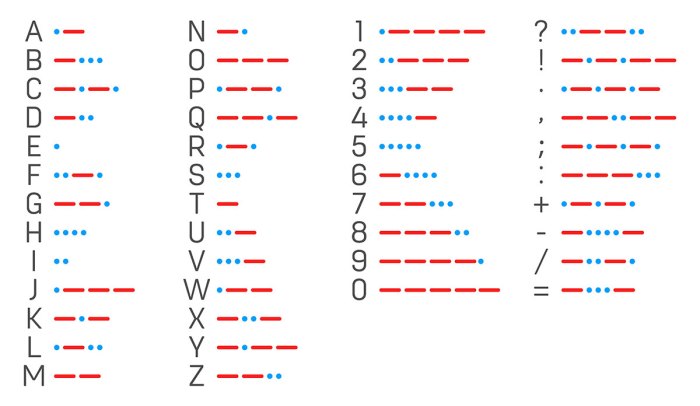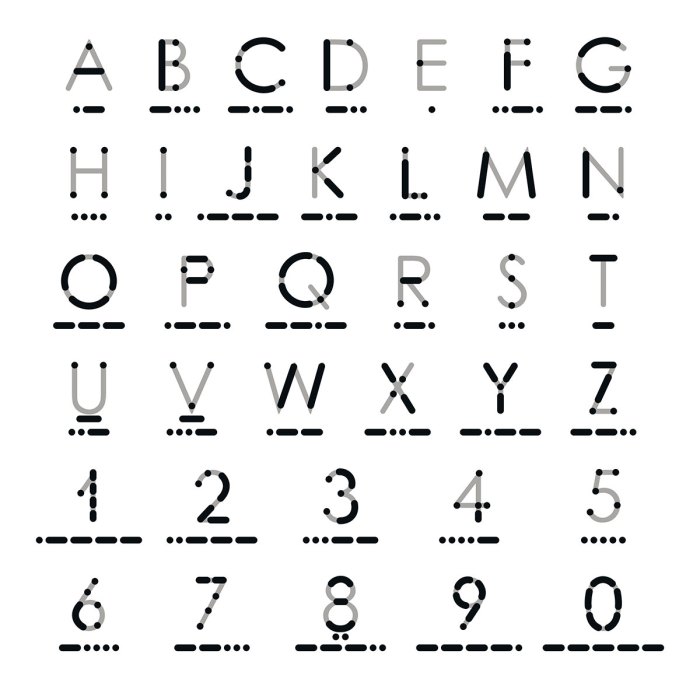Learn Morse Code With This Morse Translator and Decoder

Learning Morse code can be a fun and rewarding experience. It may seem daunting at first, but with practice, anyone can learn to interpret and transmit messages with dots and dashes.
Use this helpful tool to translate between Morse code and text. To begin, please enter words or Morse in the Input box and press Translate.
HELPFUL HINTS FOR USING THE MORSE CODE TRANSLATOR
How to translate Morse to text:
- Enter Morse dashes or dots into the input box using period (.) and minus sign (-)
- Morse letters must be separated by 1 space
- Morse words must be separated by 3 or more spaces
- You can use / to separate Morse words. There must be at least 1 space before and after each separator used
How to translate text to Morse code:
- Enter text into input box
- Characters that cannot be translated into Morse will be ignored
- If both Morse and text is entered, the converter will assume Morse mode
The Morse Generator and Translator is based on code developed by Kurt Grigg.
WHAT IS MORSE?
Morse code is a method of communicating with a series of sounds or lights that can be understood only by someone who knows the code.
Each Morse symbol represents either a letter or number and is represented by a unique sequence of dots and dashes. The duration of a dash is three times the duration of a dot.
Samuel F.B. Morse invented a code that was used to send messages over electric telegraphs in the 1830s. The SOS distress signal — three dots, three dashes, three dots — proved to be a simple way to communicate in an emergency.
With the invention of the telephone (and, later, two-way radios and cellphones), Morse is nowadays used mostly just for fun by amateur radio operators. Certain amateur radio bands are still reserved for Morse code use.
Are you interested and codes and ciphers? Find out how to make a secret-code wheel or invisible ink on Scoutlife.org.
HOW CAN I LEARN MORSE CODE?
One of the best ways to start learning Morse is to use an online translator like the one on this page. These tools give you the chance to practice and test your abilities.
A chart like this one can also help you learn Morse code by visualizing the dots and dashes on the letters of the alphabet:

A great way to practice is by listening to Morse transmissions on the radio. Many amateur radio operators still use Morse, and you can tune in to their transmissions and try to interpret the messages. You can also join a amateur radio club or group to practice with other enthusiasts.
Learning Morse may seem like an outdated skill, but it can be a fun and rewarding hobby. It can also be useful in emergency situations when other forms of communication are unavailable. With a bit of practice and dedication, anyone can become proficient and enjoy the thrill of transmitting and receiving messages in this classic code.
TESTING THE TEST
Really cool, except for one bug in the “listen and guess” test. Test 1 played and showed the Morse Code for 2 (..- – -) when it expected me to press the 3 button. As far as I can tell, Test 1 never actuall plays 3 (…- -) at all, though it does expect you to press the 3 button sometimes for the 2 code. It plays the correct code for 2 (..- – -), so its confusing when it comes to 2s and 3s, which seemed to happen very often.
Does it test “full stop,” “comma,” and “query”? They never came up for me and I went for about a thousand symbols on each test before getting tired. Also the letter “c” came up only once on each test, even though I say the other numbers and letters each about a half a dozen times or more, but that could have just been random chance.
(Reposted to clear up some ambiguous dashes)
The old is back!! Imagine a nuclear war… everything devastated … we better learn this. 😉
This is a very good way to learn Morse Code.
This isn’t hard! If you just practice beeping in your name for a while each day, then move on to your families names and then more words and stuff, it really helps!
I think this tool is awesome, I can do all our names without thinking!
Come on guys!
Cback123’s Morse code thing says “hi”
This is an important mode of communication. Something that shouldn’t be ignored or written off as ‘too hard’. While it is no longer required in the United States to know Morse Code to obtain your amateur radio operator license, it is still a great skill to get and keep. I got my amateur (or ‘ham’) license in 2000 and my one regret is I didn’t get it when I was younger so I could enjoy it more. Contact your local amateur radio club to learn more, or visit the American Radio Relay League to know more. A responsible Scout knows there is more than one way to communicate, especially if there is an emergency. Think about it.
This was pretty cool, even though i only have a few words down. Ya never know, it might come in handy 1 day. Decifer this: …. ..
Verygood instrument to beginers. Thankyou
Hey, guys! If you don’t know anything about Morse Code, just get a piece of paper and go to the Main Page and write all the letters of the alphabet and all the numbers except 10 and write down even the Fullstop, the Comma, and the Query. Then look at everyone’s Morse Code and write them down in the right places. Then go to Test 1 or 2. When it asks you to convert a letter or to find the right letter that goes with the code, look at your piece of paper, find the letter or code their asking for, and DO IT!!!!
You’ll zip right through this.
From,
superspiderman
P.S:When you’re on Test 2, it never stops asking you questions.
P.S.S:Use the back of the piece of paper to write down information if nesscessary.
this games deadsville!